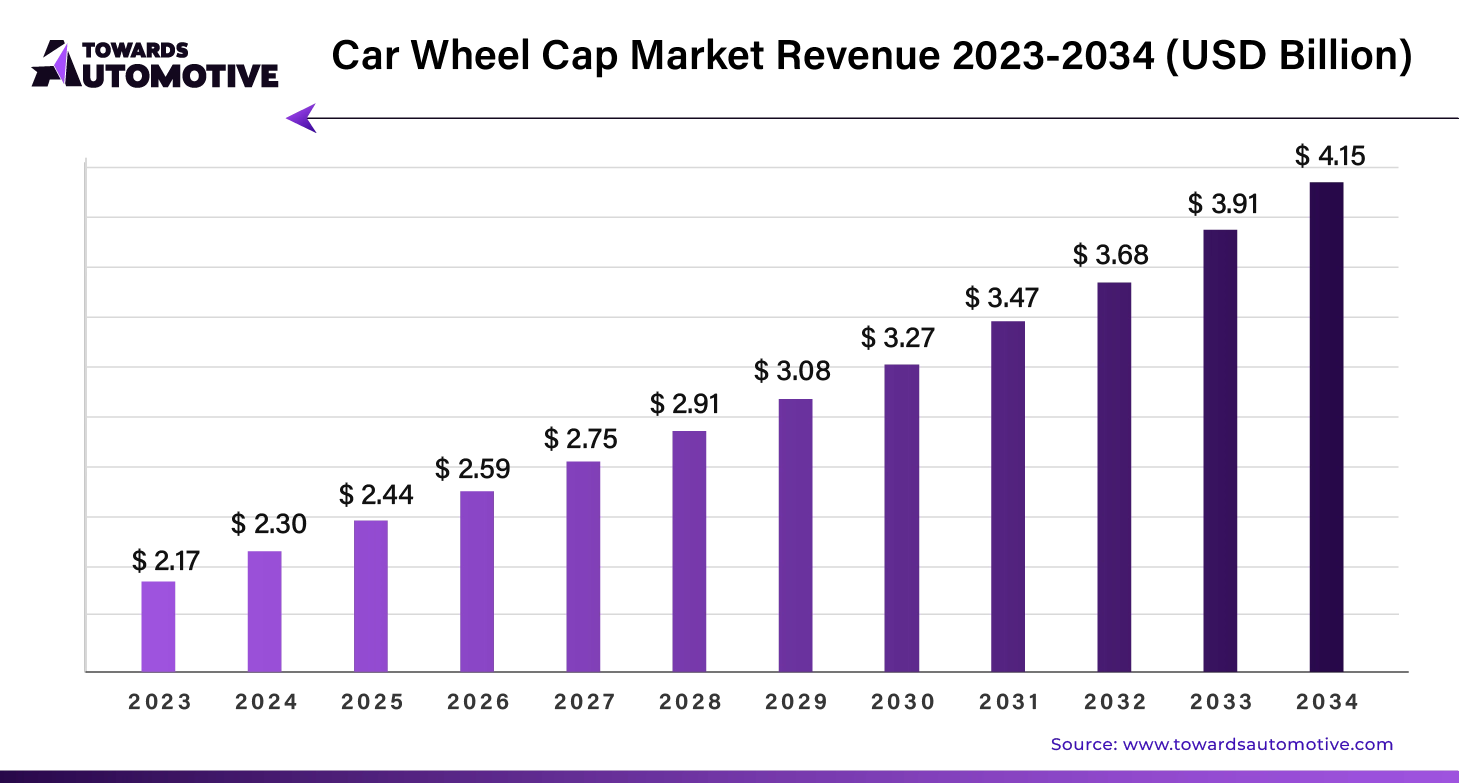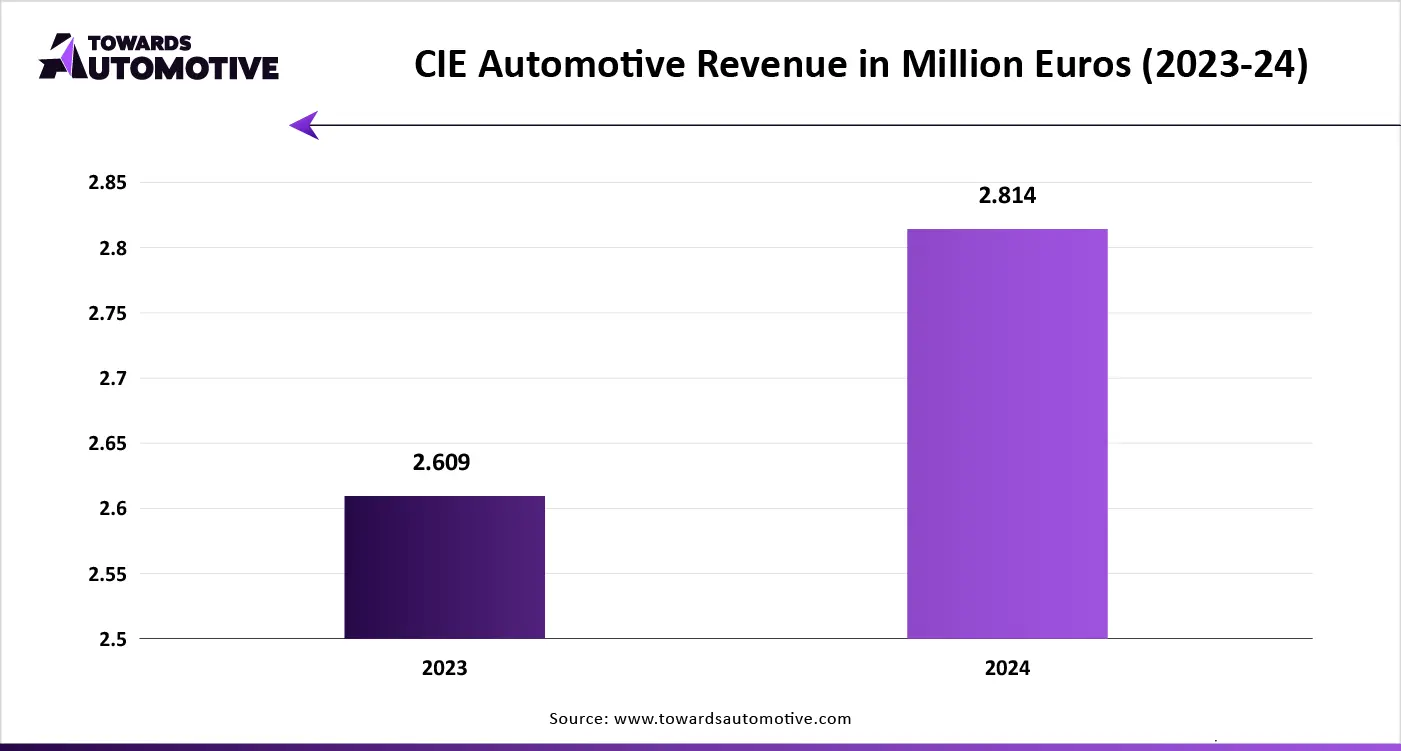October 2025
The car wheel cap market is forecast to grow at a CAGR of 6.0%, from USD 2.44 billion in 2025 to USD 4.15 billion by 2034, over the forecast period from 2025 to 2034. The growing demand for fuel-efficient vehicles coupled with rise in number of car modification shops in different parts of the world has boosted the market expansion.
Additionally, rapid investment by market players to develop a wide range of wheel caps along with surging adoption of EVs in the APAC region is playing a vital role in shaping the industrial landscape. The rising use of carbon fiber composites for manufacturing wheel covers of sports cars is expected to create ample growth opportunities for the market players in the upcoming days.

The car wheel cap market is a prominent sector of the automotive industry. This industry deals in the manufacturing and distribution of car wheel caps in different parts of the world. There are several types of wheel caps developed in this sector comprising of standard hubcaps, full wheel covers, center caps, spinner hubcaps and some others. These wheel caps are manufactured using different types of materials consisting of plastics, stainless steel, aluminum alloy and some others. It is designed for numerous types of vehicles such as low-range vehicles, mid-range vehicles, high-range vehicles and some others. The car wheel caps are available in a well-established supply chain including OEMs and aftermarket. This market is expected to rise significantly with the growth of the EV sector around the globe.
The major trends in this market consists of rising sales of passenger cars, business expansions, rapid adoption of electric vehicles.
The 16-17 inches segment led the car wheel cap market. The growing sales of SUVs in several countries such as India, Canada, Mexico, Singapore and some others has boosted the market expansion. Additionally, the rising demand for 16-17 inches wheel caps from luxury sedan owners is contributing to the industry in a positive manner. Moreover, rapid investment by wheel cap brands to manufacture 16-17 inches wheel caps is expected to boost the growth of the car wheel cap market.
The 12-15 inches segment is expected to rise with the highest CAGR during the forecast period. The rising use of 12-15 inches wheel caps in hatchbacks to enhance their looks and increase fuel efficiency has driven the market growth. Also, collaborations among third-party vendors and automotive companies to manufacture 12-15 inches wheel covers is playing a vital role in shaping the industrial landscape. Moreover, the growing demand for plastic-based 12-15 inches wheel caps is expected to foster the growth of the car wheel cap market.
The stainless-steel segment held the largest share of the car wheel cap market. The growing demand for steel-based wheel caps from passenger car owners has driven the market expansion. Additionally, rapid investment by market players to manufacture a wide range of stainless-steel based car wheel caps is playing a crucial role in shaping the industry in a positive manner. Moreover, numerous advantages of stainless-steel including high strength, excellent corrosion resistance, durability, aesthetic appeal and some others is expected to boost the growth of the car wheel cap market.
The aluminum alloy segment is expected to rise with the fastest CAGR during the forecast period. The rising use of aluminum alloy in luxury vehicles to enhance their overall looks has boosted the market growth. Also, partnerships among wheel cap manufacturers and automotive brands to develop aluminum-based wheel covers is playing a vital role in shaping the industrial landscape.
Moreover, numerous benefits of aluminum alloys including lightweight nature, high strength-to-weight ratio, excellent corrosion resistance, good electrical and thermal conductivity, recyclability and some others is expected to propel the growth of the car wheel cap market.
The mid-range segment dominated the car wheel cap market. The growing demand for mid-ranged passenger cars in several developed nations such as the U.S., China, Germany, UK and some others has boosted the market expansion. Also, rapid investment by market players to develop a wide range of wheel caps for mid-range vehicles is playing a vital role in shaping the industrial landscape. Moreover, partnerships among passenger car manufacturers and wheel cap companies for manufacturing steel-based wheel covers for mid-range hatchbacks is expected to drive the growth of the car wheel cap market.
The low range segment is expected to rise with the highest CAGR during the forecast period. The increasing sales of low-range vehicles in various countries such as Thailand, Vietnam, Indonesia, Somalia and some others has driven the market growth. Additionally, the rising use of plastic-based wheel covers in low-range passenger cars to enhance their looks is contributing to the industry in a positive manner. Moreover, rapid investment by automotive brands for developing low-range passenger cars is expected to boost the growth of the car wheel cap market.
The conventional cars segment held the largest share of the car wheel cap market. The growing demand for high-performance cars among racing enthusiasts has boosted the market expansion. Additionally, rapid investment by automotive component brands to manufacture gasoline-powered cars coupled with availability of conventional car wheel caps in online platforms is playing a vital role in shaping the industrial landscape. Moreover, collaborations among conventional car brands and wheel cap manufacturers to develop high-quality wheel caps is expected to propel the growth of the car wheel cap market.
The electric cars segment is expected to grow with the highest CAGR during the forecast period. The increasing demand for electric vehicles in several countries such as the U.S., China, India and some others has driven the market growth. Additionally, numerous government initiatives aimed at developing the EV charging infrastructure coupled with technological advancements in the EV sector is positively contributing to the industry. Moreover, partnerships among EV manufacturers and wheel cap brands to manufacture light weight wheel caps for EVs is expected to foster the growth of the car wheel cap market.
The aftermarket segment led the car wheel cap market. The growing demand for low-range wheel caps in several mid-income countries has boosted the market expansion. Additionally, rapid investment by car accessories companies to develop a wide range of wheel caps along with rise in number of aftermarket e-commerce platforms is playing a vital role in shaping the industrial landscape. Moreover, the availability of wide-range of wheel caps in aftermarket outlets is expected to boost the growth of the car wheel cap market.
The OEM segment is expected to grow with the fastest CAGR during the forecast period. The rising emphasis of automotive consumers to use genuine accessories in cars has driven the market growth. Also, the availability of high-quality wheel caps in automotive OEM service stations is contributing to the industry in a positive manner. Moreover, partnerships among automotive OEMs and wheel cap manufacturers is expected to drive the growth of the car wheel cap market.
Europe dominated the car wheel cap market. The rising sales of luxury vehicles in several countries such as Germany, France, UK, Italy and some others has boosted the market expansion. Additionally, numerous government initiatives aimed at increasing awareness about EVs coupled with rapid investment by market players for opening up new production facilities is contributing to the industry in a positive manner. Moreover, the presence of various market players such as Versaco s.r.o., CIE AUTOMOTIVE S.A, Zanini Auto Grup SA and some others is expected to drive the growth of the car wheel cap market in this region.
Asia Pacific is expected to expand with the highest CAGR during the forecast period. The growing sales and production of passenger cars in several nations such as India, China, Japan, South Korea and some others has driven the market growth. Also, the availability of raw materials at cheap prices coupled with rise in number of automotive startups is playing a vital role in shaping the industrial landscape. Moreover, the presence of several market players such as Marui Sum, Swell Marui Automobile Parts Co., LTD, Auto Pearl Automotives and some others is expected to propel the growth of the car wheel cap market in this region.
The car wheel cap market is a rapidly developing industry with the presence of a few dominating players. Some of the prominent companies in this industry consists of Suburban Wheel Cover Company, RealWheels Corporation, Swell Marui (Guang Zhou) Automobile Parts Co., LTD, Marui Sum (Thailand) Co., Ltd., CIE AUTOMOTIVE S.A., Hubcap Mike, Inc., Versaco s.r.o., Zanini Auto Grup SA, Molten Corporation, Auto Pearl Automotives and some others. These companies are constantly engaged in manufacturing wheel caps for cars and adopting numerous strategies such as launches, expansions, joint ventures, business expansions, partnerships, collaborations, acquisitions, and some others to maintain their dominance in this industry.


By Size
By Material
By Vehicle Type
By Fuel Type
By Sales Channel
By Region
October 2025
October 2025
October 2025
September 2025
We offer automotive expertise for market projections and customizable research, adaptable to diverse strategic approaches.
Contact Us